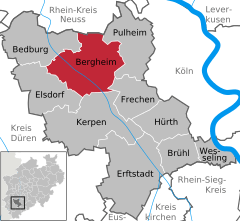Bergheim, North Rhine-Westphalia
| Bergheim | ||
|---|---|---|
|
"Aachener Tor" Landmark of Bergheim | ||
| ||
 Bergheim | ||
Location of Bergheim within Rhein-Erft-Kreis district 
 | ||
| Coordinates: 50°58′N 6°39′E / 50.967°N 6.650°ECoordinates: 50°58′N 6°39′E / 50.967°N 6.650°E | ||
| Country | Germany | |
| State | North Rhine-Westphalia | |
| Admin. region | Köln | |
| District | Rhein-Erft-Kreis | |
| Government | ||
| • Mayor | Maria Pfordt (CDU) | |
| Area | ||
| • Total | 96.33 km2 (37.19 sq mi) | |
| Population (2013-12-31)[1] | ||
| • Total | 59,272 | |
| • Density | 620/km2 (1,600/sq mi) | |
| Time zone | CET/CEST (UTC+1/+2) | |
| Postal codes | 50126, 50127, 50129 | |
| Dialling codes | 02271 | |
| Vehicle registration | BM | |
| Website | Kreisstadt Bergheim (German) | |
Bergheim is a German city 20 km west of Cologne and the capital of the Rhein-Erft-Kreis. The city's Niederaußem district is one of the most important suppliers for energy from lignites in Europe.

Geography
Bergheim is about 20 km west of Cologne, approximately 72 metres above sea level. The highest point is the Glessener Höhe (Glessen Height) at 204 metres. The Erft River flows nearby. The city lies in the Zülpicher Börde, which belongs to the Kölner Bucht. Economically and geographically Bergheim is in the Rhenish lignite coalfield.
History
Dating from about 4000 BC there is a grave hill field in Niederaußem. Around 50 BC the Romans settled in Bergheim. They constructed the major Roman road, the Via Belgica, that crossed the area where Bergheim is today. Later the Franks took control over the region. In the Middle Ages Bergheim was granted city rights and later became part of the county Jülich. In the 19th and 20th century Bergheim grew rapidly through the settlement of industry based on the local lignite coal. In World War II the Wesseling synthetic oil plant was bombed during the Oil Campaign of World War II. Then in April 1944 a large underground plant for synthetic oil manufactured from lignite was set up outside Bergheim.[2]
Districts
- Ahe
- Auenheim
- Bergheim-Mitte
- Büsdorf
- Fliesteden
- Glesch
- Glessen
- Kenten
- Niederaußem
- Oberaußem
- Paffendorf
- Quadrath-Ichendorf
- Rheidt-Hüchelhoven
- Thorr
- Zieverich
Points of interest
Points of interest are the Niederaussem Power Station with the world's tallest cooling tower as well as the Naturpark Kottenforst-Ville.
| Wikimedia Commons has media related to Bergheim. |
References
- ↑ "Amtliche Bevölkerungszahlen". Landesbetrieb Information und Technik NRW (in German). 4 September 2014.
- ↑ "Meeting No. 45/6" (PDF). Enemy Oil Intelligence Committee. February 6, 1945. Retrieved 2009-03-22.
| ||||||||
http://www.wiktorp.cku.szkola.pl/Bergheim/Bergheim.htm

